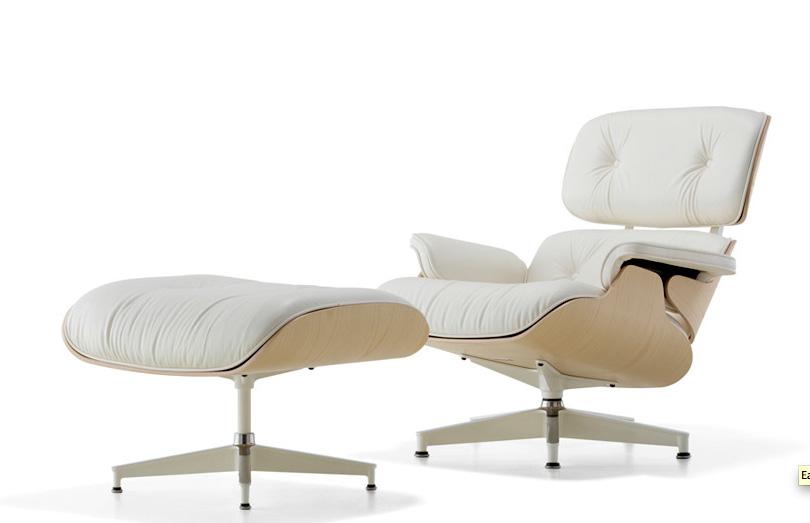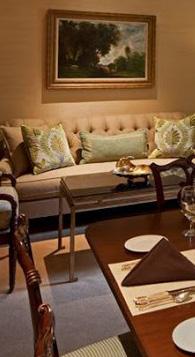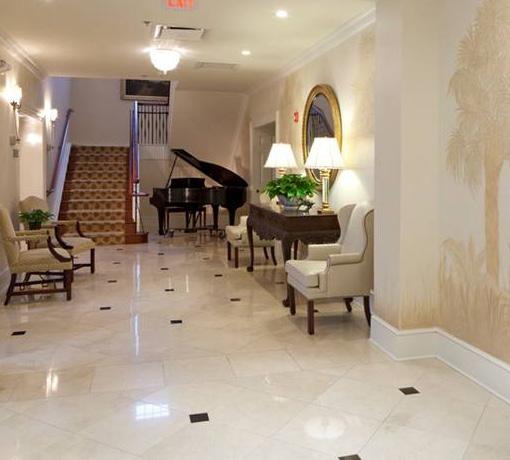COLUMBIA, SC COMBINES TWO CITY CLUBS INTO A BIGGER, BETTER — BEAUTIFUL — PALMETTO CLUB
Not What They Used to Be

ISSUE Nº 10 • WINTER 2014 hot products The VIP Treatment p. 2 Weddings v. The Member Experience p.6 city clubs
they’re better!) p.7 A Chambers Publication
(hint:
p.4
A Marriage of Equals
Friends —
Happy New Year!
Like you, we typically start the year taking a look at where we’ve been, where we’re going. (And yes, we also promise to eat better, return emails promptly and make time to organize our sock drawers.)
That looking back/looking forward mindset is a constant for clubs. Clubs look back, cognizant of the need to maintain their legacies, personalities and cultures, even as they evolve.
Looking forward, clubs seek to balance the past with the need to respond to and even anticipate changing member needs. The minute we stop assessing and improving is the minute we risk becoming blind to the need for change.
We’ve focused a good bit of this issue of CLUB ROAD on change born of clubs’ self-awareness. We profile a club merger, open a pro vs. con discussion on non-member events, and take a look at how city clubs are doing more than keeping up.
Weigh in — we always welcome your thoughts!
Regards,


VIP The
(Lounge) Treatment
club business centers are taking their cues from the airline industry
Clubs are catering more to the changing ways their members work by creating environments conducive to doing actual business on club grounds. What we’re seeing (and creating): tranquil spaces that incorporate high design and technology options, some that take their inspiration from airline VIP clubs that are catering to the needs of jet-setting business travelers.
Our friend and partner Glen Jones, director of new business and design at Harris Design in Dallas and designer of VIP airline lounges, weighs in with his must-have products for a user-friendly, stylish work environment — one where real work gets done.
Rick Snellinger President & CEO
Bob Hickman Chairman of the Board

DON’T LAUGH!
It really is the most important feature of a well stocked business center, says Jones. “Members don’t need privacy nearly as much as they need a place to plug in.”

a note from chambers 2 ] chambersusa .com
chambers is proud to be a cmaa cap sponsor . ALLIANCE PARTNER BRONZE
For product information, contact Club Furnishings Associates at clubroad@chambersusa.com. C L UBH O U SE FURNISHINGS ASSOCIATES
hot products
WORK, WORK, WORK…STATION
You don’t need a lot of desk space. But the more comfortable, user friendly and attractive your desk stations are, the more they’ll be used. Height adjustable tables by Teknion

TAKE A STAND
PICK YOUR SEAT
Working isn’t just for desks anymore. The modern business center has a relaxing, loungelike atmosphere.
Eames Lounge Chair and Ottoman from Herman Miller Knoll pedestal base lounge chair from 2 Modern



But where there are desks and conference tables, there must be ergonomic swivel chairs. Like the RBT (responsive back technology) chair from Teknion
Smaller, higher tables are becoming one of the most popular work surfaces on the market. The perfect pit stop for the mobile worker who wants to check email, make a quick call or jot down some notes.

COLLABORATION. EXTENDED.
ScapeSeries by Steelcase
18 99 club road Issue Nº 10/WINTER 2014 Club Road is a quarterly publication of Chambers. Managing Editor: John Snellinger clubroad@chambersusa.com 410.727.4535 planning / architecture interior design / purchasing www . chambersusa . com subscribe INSIDE this ISSUE 2 Hot Products: The VIP Treatment 4 A Marriage of Equals 6 Weddings v. The Member Experience Perspectives from The Other Side 7 City Clubs — Not What They Used to Be 8 Behind the Curtain: Skip Avery
70% of workers report using mobile technology throughout the day.* *Steelcase Workplace Satisfaction Survey 70 %
From standing height to desk height, users are invited to collaborate formally and informally. Power at the worksurface allows users to charge all of their mobile devices. The table combines corner-less curves with straight sides allowing for seamless integration into any application.
IM#: 12-0000420 IM#: 11-0003051 IM#: 12-0000419
A Marriage of
COLUMBIA, SC COMBINES TWO CITY CLUBS INTO A BIGGER,



YOU MIGHT CALL IT AN ARRANGED MARRIAGE — THE CONSOLIDATION OF THE SUMMIT CLUB IN COLUMBIA, SC AND THE PALMETTO CLUB, ITS ACROSS-THE-STREET COMPETITION. DIFFERENT IN CULTURE AND ATMOSPHERE, THE SUMMIT CLUB WAS LARGELY A BUSINESS CLUB, ATTRACTING A YOUNGER MEMBERSHIP THAN THE PALMETTO CLUB, FROM ITS PERCH ON THE 20TH FLOOR. THE PALMETTO CLUB’S LOW-RISE, STATELY BRICK FAÇADE CONJURES A CLASSIC SOUTHERN ESTATE AND WAS DESIGNED AS A PLACE FOR BUSINESS LEADERS AND THEIR FAMILIES TO ENTERTAIN AND RELAX LARGELY POST-WORKDAY.
But marry they did.The why is a bit more straightforward than the many nuances the clubs faced in becoming as one: financial viability. Both clubs were undergoing planning processes (Chambers was initially working with The Palmetto Club), looking at their best options going forward. As they both reviewed their respective outlooks and the make-up of downtown Columbia, it became increasingly apparent that the clubs would be much stronger as one entity, versus competing for membership. (This conversation — or ones like it — are going on at city clubs across the country.
See City Clubs — Not What hey Used to Be on page 7.)
featured 4 ] chambersusa .com subscribe
THE HIGH IMPACT TAP ROOM FEATURES AN EXPOSED CEILING, MODERN FURNISHINGS AND UPDATED MENU.
THE CLUB LOBBY WAS EXPANDED AND BRIGHTENED.
UPDATED PRIVATE
SPACES ARE ALSO
MEETING
TECHNOLOGY-ENABLED.
Equals
— BEAUTIFUL — PALMETTO CLUB
The clubs’ ultimate decision to consolidate into The Palmetto Club’s space and expand from there also came down to a pretty simple financial equation: The Palmetto Club owned its building, The Summit Club did not.

The “new” club would retain The Palmetto Club name, but how to combine the two clubs, make spaces — and room — for an age-diverse membership, and assess all the physical assets took a lot of careful consideration and painstaking decision-making. And, certainly, it will all take some getting used to from members of both clubs. Initial reactions from
members have been very positive — and membership has stabilized after years of stagnation or decline. Consolidating space and member experience, and retooling the new club to meet the now-expanded need entailed:
•The purchase and adjoining of a building next to The Palmetto Club to enable the addition of meeting spaces and the Tap Room, a street-level casual dining and bar space that was designed to be more appealing to multiple generations of members and their guests >



clubroad@chambersusa.com [ 5 of
read the full story
MEETING AND DINING TECHNOLOGY-ENABLED.
THE PALMETTO CLUB BRAND IS INFUSED THROUGHOUT… AND BECOMING FAMILIAR, TOO, TO FORMER SUMMIT CLUB MEMBERS.
A SECOND ENTRANCE WAS ADDED FOR GREATER ACCESSIBILITY.
BIGGER, BETTER
THE BUSINESS OF WEDDINGS
Revenue generation versus the sanctity of the member relationship — just where is the line? Clubs seeking additional sources of the former may be at risk of permanently damaging the latter. The business of renting themselves out for non-member wedding events is getting a second look by many in the club industry.
Russ Conde, co-founder and chief operating officer of Club Benchmarking, says his data don’t support the rationale
THE
MEMBER EXPERIENCE v.
for hosting these non-member events. “They’re not helping equalize the food & beverage balance sheet,” he says, pointing out that, in fact, they’re often draining resources and other club assets. Certainly, that financial reality can likely only be measured on a club-by-club basis, but Conde makes but one of many arguments we hear against these forms of revenue generation. “Clubs should look at alternative, less invasive ways of generating cash — like alternative pricing strategies and increasing member events,” he says.
read the full story
What’s your perspective? Non-member weddings — a necessary evil or simply unnecessary? weigh in here.

perspectives from the other side
ENGAGING A PLANNING FIRM — DISPELLING THE MYTHS

Skip Avery, CCM, CCE, recently joined Chambers (see Behind the Curtain, page 8). And he’s launched what will be a regular Chambers blog feature — “Perspectives from the Other Side” (Skip spent more than 30 years managing clubs before he joined Chambers to bring his perspective to our club planning team).
In case you haven’t yet had an opportunity to read Skip’s first blog post, check it out here… read more >
chambersusa .com 6 ]
IS THE PRICE TOO HIGH? the club experience
Are you frequently asking your members to use side or back entrances so they don’t interrupt non-member wedding receptions? Closing primary dining spaces? Rolling out the red carpet for people who don’t pay dues, who don’t finance club improvements? Exhausting your staff while your members get the second shift?
MORE FROM CHAMBERS
MORE IS...MORE
CITY CLUBS AREN’T WHAT THEY USED TO
BE (hint: they’re better!)
The story’s a well told one by now — the evolution of city clubs from “old gentlemen’s clubs” to urban oases. The drivers are equally familiar: changing demographics, differences in the way business is now conducted, the resurgence of cities, the popularity of the boutique hotel industry and increasingly more interesting dining options. City clubs had become known, as one club recently admitted overhearing about their historic club, “…the place where old people take their parents for dinner.” It was do-or-die, go-big-or-go-home time. Here’s a list of what we’re seeing — and doing — in city clubs across the country.

What’s Affecting, Happening & Trending in City Clubs:
1. THE SEVEN YEAR ITCH (TO UPDATE).
“Hotel lobbies change every five to seven years,” says Chambers Executive Vice President and Architect Ryan Yakel, “City clubs historically don’t change but every 15 to 20.” For young business people, especially, says Yakel, that’s just not exciting enough to hold their attention.
2. TRANSITIONAL DÉCOR.
‘Contemporary’ changes too often, traditional risks being labeled “boring” or “stodgy.” City club interiors are adopting more transitional décor, an in between but fresh approach with staying power. Certainly, city clubs must be “edgier ” than their country club counterparts. read


Since acquiring CCI Club Design last year, Chambers has spent the year showcasing the combined experience, expertise and perspective of Chambers and CCI through ads, articles and, finally, with a little fun for your desk. Didn’t get your own MORE IS…MORE house of cards set? Be among the first 10 to email us with a request and we’ll send you a set. Or view the whole collection on Pinterest

clubroad@chambersusa.com [ 7
SEE OUR CITY CLUB PORTFOLIO HERE. CHECK BACK HERE AND ON OUR BLOG, SOON, FOR A PLAY-BY-PLAY LOOK AT THE TRANSFORMATION OF ONE OF OUR CURRENT CITY CLUB CLIENTS.
CITY
trending ways to connect www.chambersusa.com subscribe! baltimore 410 727 4535 dallas 972 253 3583 clubroad@chambersusa.com
THE PETROLEUM CLUB OF FORTH WORTH
CHARLOTTE
CLUB
the full story
Tales from the other side
Skip Avery, CCM, CCE
Skip joined the Chambers team in 2013 after nearly 30 years managing some of the country’s most prestigious country clubs and recently serving as president of the Club Managers Association of America (CMAA). We asked Skip what brought him from club management to club planning. We know we couldn’t be happier to have him!

cr: What made you choose the club industry?
sa: It really chose me. I’d taken a year off from college in 1980 and took a job bartending at a Van Schaick Island Country Club in New York. A year or so later, the president of the club asked if I was interested in managing the club, thinking it would be a good opportunity for me. And that was…that.
cr: What appeals most to you about the club world?
sa: The opportunity to be part of something special. Not to sound too melodramatic, but the chance to touch people’s…souls, making them feel good during every phase of their lives. Every team I led had a simple mantra: : “We’re not in the “club business,” we’re in the business of making members feel good — and the club is our tool.”
cr: As a manager and in your role as president of CMAA, you’ve done and seen clubs do many things right over the years. What one thing could they do better?

sa: They could better understand that they’re not in competition for their members’ money, they’re in competition for their time
cr: What or who have been the greatest influences on your leadership style?
sa: There are two people — my father, Dick Avery, and Peter Sallentini, CGSA, CCM. My dad taught my brothers and me two things: tell people what you’re going to do — and do it, and treat people better than they would treat you. I worked for Peter in the 80s. He taught me how to lead and inspire people, along with the importance of compassion and empathy.
read the full story
In case you haven’t yet had an opportunity to read Skip’s first blog post, check his new blog here… read more >
behind the curtain
Get in touch with Skip at savery@chamberusa.com

























